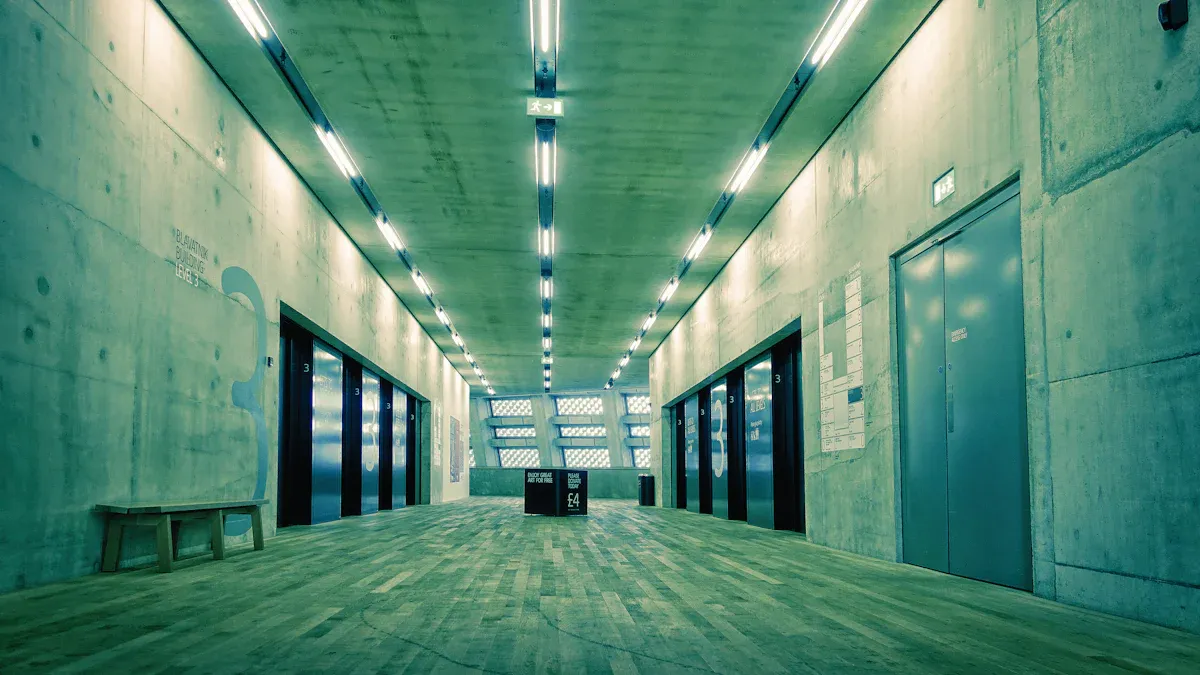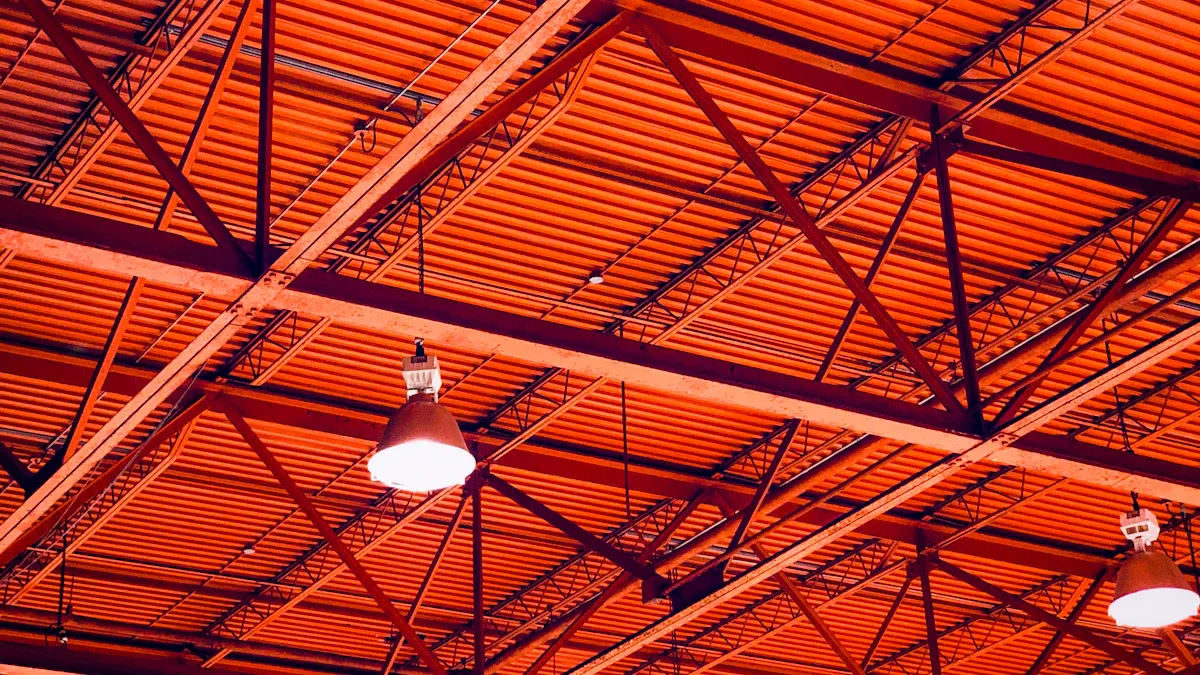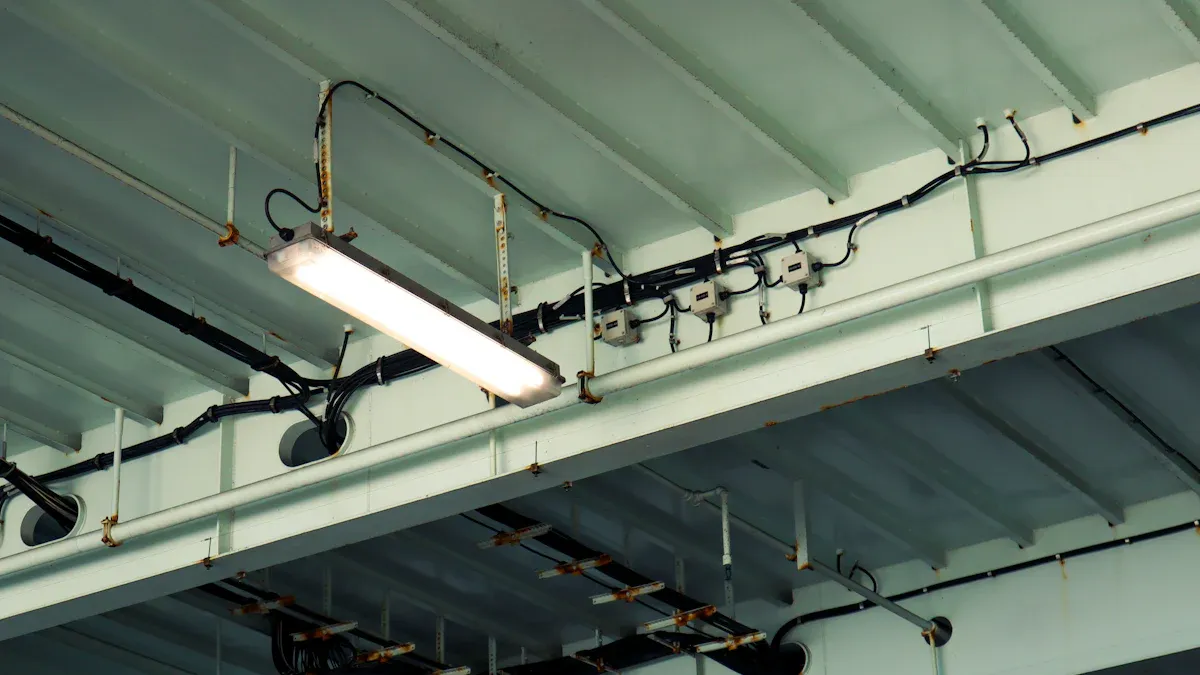How LED Lights Industrial Applications Reduce Energy Costs and Improve Workplace Safety

LED lights are transforming factories and workplaces with their numerous benefits.
They consume at least 75% less energy than traditional bulbs.
LED lights convert about 95% of energy into light, minimizing heat waste.
This results in savings on energy bills and reduces heat-related hazards.
Switching to LED lights can help decrease lighting electricity usage by 40% by 2030.
This translates to cost savings and contributes to creating safer and greener workplaces.
About Us: We are dedicated to providing high-quality LED light products that enhance efficiency and sustainability in various environments.
Key Takeaways
LED lights use much less energy than regular bulbs, saving money.
Changing to LEDs can cut energy bills by up to 80%. They often pay for themselves in less than two years.
LEDs make workplaces safer by giving brighter and even lighting. This helps stop accidents.
LEDs last longer, so they need fewer replacements. This lowers maintenance costs and reduces work delays.
Using LEDs helps the planet by cutting carbon emissions and using less energy.
Energy Cost Savings with LED Industrial Lighting

Energy Efficiency and Reduced Power Consumption
Using LED lights in factories saves a lot of energy. LEDs turn most electricity into light, wasting very little as heat. Old bulbs, like incandescent ones, lose up to 90% of energy as heat. LEDs give 80-100 lumens per watt, meaning brighter light with less power.
Switching to LED tube lights can cut energy use by 15% to 7.5%. This can save about 18,220 kWh each year, lowering electricity bills. Choosing LEDs helps save money and supports a cleaner environment.
Rating System | What It Means |
|---|---|
Energy Star | Shows energy efficiency; tested to meet EPA rules. |
A to G Scale | Rates efficiency; A is the best. |
Power Consumption | Tells how much energy (kWh) is used yearly. |
Longer Lifespan and Minimal Maintenance Costs
LED lights last much longer than regular bulbs, up to 50,000 to 100,000 hours. Regular bulbs only last 1,000 to 2,000 hours. Fewer replacements mean lower maintenance costs and fewer work interruptions.
For example, Starbucks saved $4 million by switching to LEDs. This shows how energy-saving lights can lead to big savings over time.
Aspect | LED Lights | Regular Bulbs |
|---|---|---|
Average Lifespan | 50,000 to 100,000 hours (5-14 years) | 1,000 to 2,000 hours |
Maintenance Frequency | Low (less replacing) | High (needs frequent replacing) |
Energy Efficiency | Uses 75% less energy | Uses more energy |
Cost Savings | Starbucks saved $4 million | N/A |
Lower Heat Emission and Its Impact on Utility Bills
LED lights stay cooler than old-style bulbs. They turn most energy into light, not heat. This lowers the strain on cooling systems, saving money on air conditioning.
Old bulbs waste energy as heat and can cause overheating. LEDs fix this problem, making workplaces safer and more comfortable. Switching to LEDs improves energy use and cuts utility costs.
LEDs give 80-100 lumens per watt, while old bulbs give 10-15 lumens.
Less heat means lower cooling costs and longer-lasting lights.
LEDs prevent overheating, creating safer workspaces.
Real-World Examples of Cost-Saving LED Solutions
Switching to LED lighting saves money for many businesses. Real-life examples show how industries save big by using LEDs.
One example is The Green Restaurant Initiative. A restaurant replaced old bulbs with LEDs. This cut energy use by 60% and lowered bills. The cost was recovered in under two years, proving LEDs save money fast.
Another case is The Office Retrofit Project. An office switched to LEDs, cutting energy use by 80%. The investment doubled in value with a payback time of 1.5 years. This shows how LEDs reduce costs in workplaces.
Case Study | Energy Savings | ROI (%) | Payback Period (years) |
|---|---|---|---|
The Green Restaurant Initiative | 60% | N/A | < 2 |
The Office Retrofit Project | 80% | 100% | 1.5 |
You can also estimate your savings with LEDs. For example, spending $400 on LEDs could save $219 yearly on energy and $100 on maintenance. Over five years, this totals $1,595 in savings. The ROI would be 396%, with a payback time of 1.83 years. These numbers show LEDs save money and offer long-term benefits.
Key Takeaways:
LEDs can cut energy use by up to 80%.
Payback periods for LEDs are often under two years.
High ROI makes LEDs a smart, cost-saving choice.
By using LED lighting, businesses save money and help the environment. These examples prove LEDs are a smart and future-ready investment.
Workplace Safety Benefits of LED Lights

Better Lighting to Prevent Accidents
Good lighting helps stop accidents at work. LED lights are brighter and more focused, making it easier to see dangers and move around safely. Unlike old lights, LEDs stay bright without flickering. This keeps you focused and less distracted.
Studies show LEDs can improve worker focus, mood, and performance by 25%. They also help spot hazards better. For example, NIOSH found LED cap lamps improved spotting floor hazards by 194% and motion detection by 79%. These changes lower the chance of accidents caused by bad lighting.
Evidence Type | What It Shows |
|---|---|
Better Worker Focus | LEDs improve focus, mood, and work by 25%. |
Fewer Injuries | Many injuries from bad lighting can be avoided with LEDs. |
Better Hazard Detection | LED cap lamps improve hazard spotting by 194% and motion detection by 79%. |
NIOSH also found LED cap lamps cut glare by 54%. This makes it easier to see dangers in tough areas. These lamps also help spot moving machines, making workplaces safer. Using good LED lights creates a safer and more efficient work area.
Even Lighting and Less Eye Strain
Uneven lighting causes shadows and glare, which strain your eyes. LED lights fix this by giving even light everywhere. This helps your eyes stay relaxed and focused all day.
Old lights often leave some spots too bright or too dark. LEDs spread light evenly, so every part of your workspace is well-lit. This makes work safer and reduces mistakes caused by poor lighting.
For example, in assembly lines or quality checks, good lighting helps find defects or do precise work. LEDs are great for these jobs because they give bright, even light that reduces eye strain and improves accuracy. Switching to LEDs boosts safety and work quality in factories.
Meeting Safety Rules with LED Lights
LED lights meet strict safety rules for factories. Following these rules keeps workers safe and meets legal needs. OSHA says good lighting is key to stopping accidents and keeping workers healthy.
Groups like UL Solutions and Intertek test LED lights for safety. Their certifications prove the lights meet global safety rules and work well in tough places.
UL Solutions tests LED lights to ensure safety.
Intertek checks lights with strict tests to meet safety rules.
Certified LED lights are safe, reliable, and long-lasting.
Choosing certified LEDs shows you care about safety and following rules. This helps avoid problems and builds a safe workplace culture.
Case Studies of Safety-Focused LED Applications
Real-life examples show how LED lighting makes workplaces safer. These stories explain how LEDs improve safety in different industries.
1. Mining Industry: Better Lighting in Dangerous Areas
Mining sites often have poor lighting, which increases risks. Using LED lights helps workers see better in tough conditions. One mining company switched to LED cap lamps. Workers said they could spot hazards faster and move safely. The LEDs also reduced glare, making tunnels easier to navigate.
Tip: LEDs give steady light in dark places, helping workers stay focused and avoid accidents.
2. Manufacturing Plants: Safer Work with Even Lighting
Factories need good lighting to keep workers safe. One factory replaced old lights with LEDs. This gave even light across work areas, removing shadows that caused mistakes and accidents. Workers felt less eye strain, worked better, and had fewer fatigue-related issues.
Before LED Upgrade | After LED Upgrade |
|---|---|
Uneven lighting | Even lighting |
More accidents | Fewer incidents |
High energy bills | Lower costs |
3. Warehouses: Safer Navigation in Tight Spaces
Warehouses have narrow aisles and tall shelves, creating blind spots. One warehouse added LED lights with motion sensors. The lights turned on only when needed, helping workers see clearly. This reduced collisions and improved safety in risky areas.
Note: Motion-sensing LEDs save energy while making workplaces safer.
4. Construction Sites: Bright Lights for Night Work
Construction sites need portable lights for changing work areas. One company used LED floodlights for night shifts. These lights lit up large areas, helping workers spot dangers like uneven ground or moving machines. The LEDs also used less energy, saving fuel for generators.
5. Food Processing Facilities: Safe and Clean Lighting
Food factories must follow strict safety rules. One facility switched to LED lights to meet these standards. The LEDs gave bright, steady light, helping workers see clearly during inspections. They also lasted longer, reducing maintenance stops and keeping work smooth.
Key Takeaway: LEDs improve safety and help businesses follow rules, making them a smart choice for industries.
These examples show how LED lighting improves visibility, lowers accidents, and meets safety needs. Switching to LEDs creates safer and better workplaces.
Additional Benefits of LED Lighting in Industrial Settings
Environmental Sustainability and Carbon Footprint Reduction
LED lights are eco-friendly and use much less energy. They turn 95% of energy into light, wasting very little. This makes them 80% more efficient than old-style lights. Using LEDs helps lower your carbon footprint and keeps the planet cleaner.
LEDs have a big impact on the environment. For example:
In 2017, LEDs cut 570 million tons of carbon dioxide.
New rules could reduce 222 million metric tons of carbon in 30 years.
Replacing one bulb per U.S. home with an LED saves 9 million pounds of emissions yearly.
Switching to LEDs saves energy and helps fight climate change.
Versatility Across Various Industrial Applications
LEDs work well in many industrial settings. They give steady light and need little maintenance, making them popular in different industries. Solid-state lighting (SSL) is a great choice for saving energy.
LEDs are used in many ways, such as:
Industrial: Lowering energy costs with controlled lighting.
Outdoor Streets & Roads: Eco-friendly lights with daylight-saving features.
Architectural Buildings: Adding beauty with creative lighting effects.
Sports Complexes: Wide beams for better coverage.
Tunnels: Safer travel with brighter lighting.
In farming, LED grow lights help plants grow better. In cars, bright LEDs improve performance. These examples show how useful LEDs are in many industries.
Smart LED Features for Energy Optimization and Safety
Smart LEDs make saving energy and staying safe even easier. They can save up to 90% more energy than old lights. Smart systems let you set schedules, change brightness, and track energy use.
Smart LEDs also make workplaces safer. They light up important areas and can work with cameras to spot problems. For instance, motion-sensing LEDs in warehouses only turn on when needed. This saves energy and keeps workers safe. These features make smart LEDs a great choice for factories.
Using smart LEDs lowers costs, saves energy, and improves safety at work.
LED lights are changing how factories light their spaces. They save energy and make workplaces safer. LEDs last a long time and have useful features. Using them lowers energy bills and improves how well workers can see. This makes work safer and helps the environment too. Switching to LED lights is a smart way to save money and work better. It’s a step toward a safer and greener future for factories.
FAQ
1. How do LED lights save energy compared to old bulbs?
LEDs turn 95% of energy into light, wasting little as heat. Old bulbs waste up to 90% of energy as heat. This makes LEDs use less electricity and lowers energy bills.
2. Are LED lights safe for factories and workplaces?
Yes, LEDs follow strict safety rules. They give even light, reduce glare, and improve visibility. Certified LEDs are reliable and safe for tough work areas.
3. Can LED lights help stop workplace accidents?
Yes! LEDs give bright, even light that helps workers see better. This makes it easier to spot dangers and avoid accidents, keeping workplaces safer.
4. How long do LED lights last in factories?
LEDs can last up to 100,000 hours, much longer than old bulbs. They need fewer replacements, saving time and money on maintenance.
5. Do LED lights help the environment?
Yes, LEDs use less energy and make fewer carbon emissions. Switching to LEDs helps lower your carbon footprint and protects the planet.
See Also
Exploring LED High Bay Lights: Uses, Advantages, and Setup Tips
Choosing Industrial LED Bulbs: Effectiveness, Uses, and Options
Commercial Outdoor Lighting: Enhancing Safety, Efficiency, and Aesthetics
Indoor LED Lighting: Energy Savings, Varieties, and Uses in Contemporary Areas
Advantages of LED Lights: Transforming Energy Use and Savings

